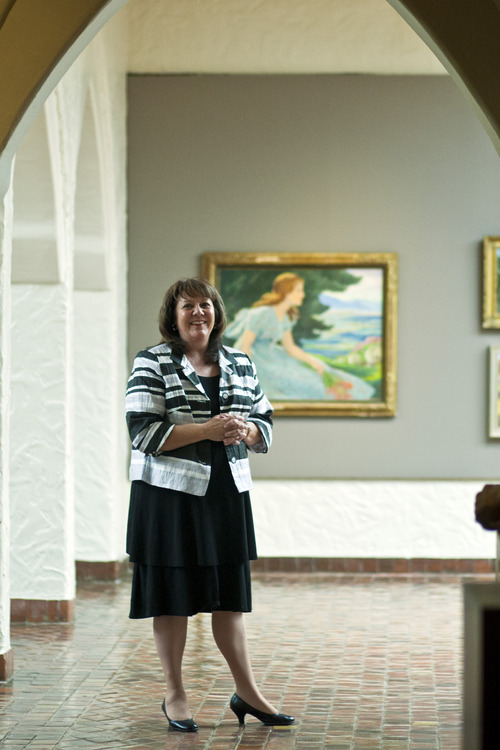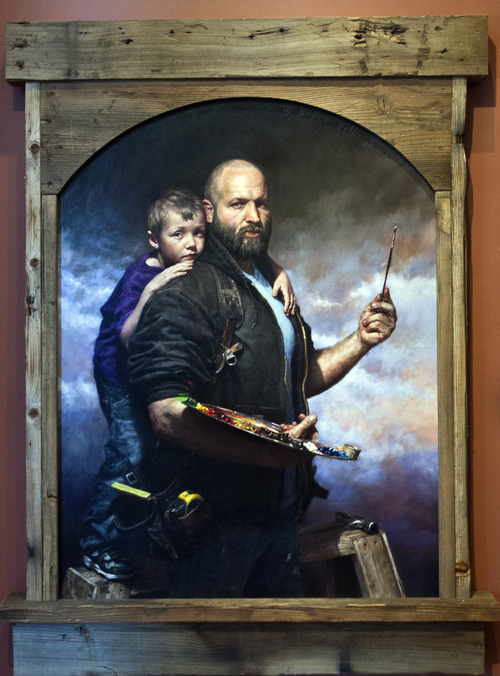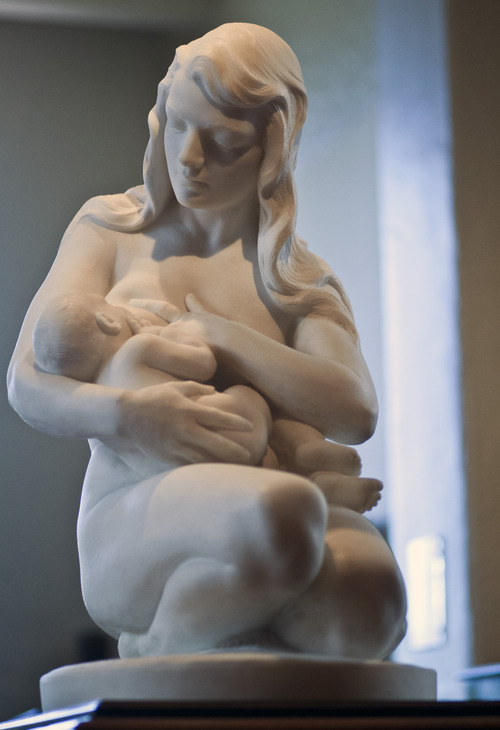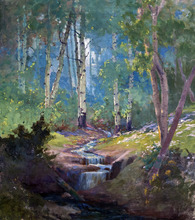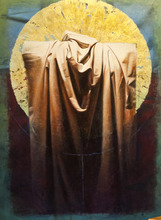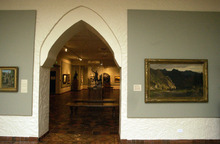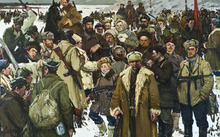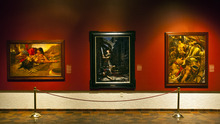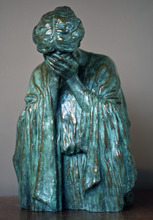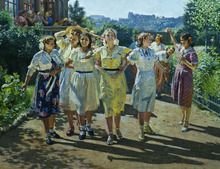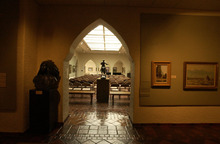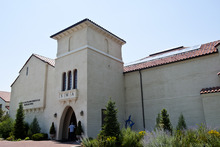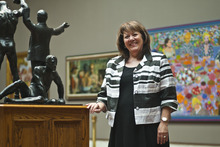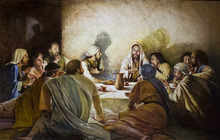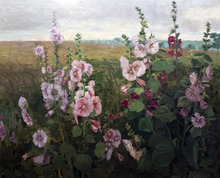This is an archived article that was published on sltrib.com in 2013, and information in the article may be outdated. It is provided only for personal research purposes and may not be reprinted.
Springville • Diana Lauritzen, the Springville Museum of Art's interim art curator, wears an aged white "Hunger Banquet" T-shirt with Spalding Gray paint haphazardly flecked across it.
Today employees are painting the museum's East Gallery — 2,300 square feet of wall space — in preparation for the new exhibit "Voices: People, Places, and Ideas in Utah Art." The exhibit represents the new, the familiar and the turning of a page for the Utah County museum.
It's a subtle change — a maturing, if you will — in the museum's presentation of works: Pieces will be placed to evoke a "conversation" between them, said museum director Rita Wright.
Wright, the museum's director since late 2012, succeeded Vern Swanson, who had been in the position for 32 years. She brings a fresh perspective and a curator's hand to the works to be displayed.
For instance, among the museum's treasured works is Avard Fairbanks' "Mother and Child," a sculpture of white carrara marble that depicts a mother — Fairbanks' young wife — serenely breastfeeding her infant.
It also includes "Grief Portrait of Lillie Annetta Huish Fairbanks," a sculptured bust by Fairbanks' brother, J. Leo, which depicts his mother's anguish. The piece, according to stories, represents J. Leo's heartache: When he was an infant, his mother was carrying him in one arm, a lamp in the other, as she walked down the stairs — only to lose her balance and, to save him, fall in such a way that she hit her head. She died from the resulting trauma.
An oasis of fine art, the Springville Museum is a far cry from its small beginnings of two donated works, which were given not to an art museum, but to Springville High School at the turn of the 20th century.
—
Beginnings • If the community was to appreciate art, argued then-school Superintendent Lars Eggertsen, this love would be best developed in Springville's youth. With this in mind, John Hafen and Cyrus Dallin, art missionaries for The Church of Jesus Christ of Latter-day Saints who studied in Paris, each donated a work to the high school in 1903.
Dallin's work was a plaster of Paul Revere; Hafen's an oil painting titled "The Mountain Stream."
Hafen's Parisian training in impressionistic art is evident in "The Mountain Stream." The edges of the peaceful scene painted in muted greens are less defined in the foreground; the more detailed images of trees in the background "bring the eye backwards," noted the museum's associate director, Natalie Petersen.
It is this work, outlined in an ornate gold frame, that Hafen hoped would be the piece around which a collection would be built, Petersen said.
According to Swanson, in his official history of the museum, Hafen's enthusiasm, along with that of a few other visionaries, inspired an art movement and talk of a gallery. But an art collection would need funds, and in 1907 the Springville City Council instituted a tax for that purpose. The Springville School Board, as well as teachers and students, also donated funds.
The auditorium of the brand new Springville High School was the site of the gallery, which opened in 1907. Named the Art Institute of Springville, it opened its doors with 15 works of art, and the community became Art City.
Springville High School also began its Art Queen popularity contest that simultaneously raised funds and interest in the acquisition of new pieces. Art Queen candidates were nominated, and students cast "penny votes" for their favorite nominee. The pennies were then used to purchase a piece for the collection.
—
Influence • Springville Museum of Art volunteer Collette Binks has been intertwined with the museum for 67 years. Her first interaction with the museum was in sixth grade when she and her classmates trekked to the museum to choose a work of art to write about. Binks, with a laugh, remembers choosing a work by painter Marguerite Pearson. "It was a lady in front of the piano," she said.
Binks remembers the museum's addition of Fairbanks' "Mother and Child" and the piece her Class of 1953 purchased. The painting of a coal miner is "dark and sad," she said, a story of "toil and labor."
Springville's art has left its indelible imprint on her life, as it has for the entire community. The Spanish colonial revival building — the museum's home at the corner of 100 East and 400 South — was constructed during the Great Depression for $104,011, according to Swanson's history.
Several sources helped cover the cost, including $54,000 Works Progress Administration grant, $25,000 donation from Springville City and the LDS Church, and an additional $25,000 donated by the townspeople through fundraising.
Through the years, the museum's exhibits have featured the work of American painter Wayne Thiebaud, beloved American painter and illustrator Norman Rockwell and even turn-of-the-20th-century French painter William-Adolphe Bouguereau, as well as works collected by internationally known Australian businessman John Schaeffer.
Perhaps the museum's greatest influence has been its impact on the lives, and work, of Utah artists.
That is the case for Utah artist Frank McEntire, whose first individual exhibition at the Springville Museum was in 1989. "Divining," as it was called, offered a large gallery in which to display his work, and McEntire created works specifically for the showing.
"It offered me the freedom to explore and experiment," McEntire said. The museum's invitation not only was a form of encouragement but helped him set a path for his work. "With all of the work in one place, it helps you to see the direction you're headed — it informs the next step."
The Springville museum also is a "breakout venue" for talented Utah artists, said Brigham Young University Museum of Art director Mark Magleby. A museum showing can "jump-start a career."
It is continued high praise for a museum that, despite — or perhaps because of — its small beginnings, is considered, in Swanson's words, "a Mecca of art in the Rockies."
Voices: People, Places, and Ideas in Utah Art
When • Through 2016
Where • Springville Museum of Art, 126 E. 400 South, Springville; 801-489-2727
Hours • Tuesday, Thursday-Saturday, 10 a.m. to 5 p.m.; Wednesday, 10 a.m. to 9 p.m.; Sunday, 3 to 6 p.m. Closed Mondays and holidays. The first Monday of the month is Community & Family Night, when the museum stays open from 6 to 8 p.m.
Tickets • Free; smofa.org





